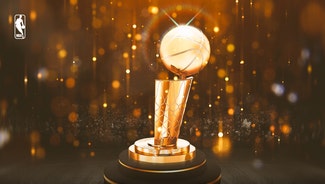
The origin of Dame Time: Tracing Damian Lillard's history of clutch shots
By Yaron Weitzman
Special to FOX Sports
Editor's Note: This story was originally published on April 14, 2021. We are republishing it now in light of Lillard's 55-point performance in Game 5 against the Denver Nuggets on Tuesday night.
Weber State trailed Northern Colorado by three with 22 seconds left in the game. Everyone in the gym knew where the ball was going.
Damian Lillard was on the floor, but this was B.D.T. — Before Dame Time — so the play called by Weber State head coach Randy Rahe was not for him. A freshman point guard at the time, Lillard’s job was to bring the ball across half court and find Kellen McCoy, the team’s leading scorer.
There was just one problem: Northern Colorado’s plan was to double McCoy, forcing someone else to take Weber State’s final shot. The decision left Lillard — a middle-of-the-road, two-star recruit playing in his first Big Sky Conference game — with the ball in his hands with the game on the line for the first time in his collegiate career.

Damian Lillard's history of hitting clutch shots began as a freshman at Weber State in January 2009. (Photo courtesy of Weber State Athletics)
Earlier that evening, the pressure had ruffled Lillard. He had attempted only two shots in the first half, failing to score a single point. His poor play was one of the reasons Weber State was down 12 with just 4:54 remaining.
Lillard, in other words, was the player Northern Colorado wanted to have the ball. Which is why what happened next stunned those in the building, even if it wouldn’t surprise anyone who has followed the NBA over the past decade.
Lillard called for a screen, took two dribbles to his left and rose up from about 22 feet out. "The shot was so deep," T.J. Benson, a junior teammate, said. The ball splashed through the net, tying the game.
Just like that, Dame Time was born.
"At that moment I wasn’t nervous, I was just like, ‘I’m about to shoot it,’" Lillard, now 30 and a six-time All-Star for the Portland Trail Blazers, recalled during a recent phone interview with FOX Sports. "I think when it’s a broken play, you feel less pressure because it wasn’t supposed to happen anyway."

Lillard was the sixth pick of the 2012 NBA Draft, which ended up being a steal for the Blazers. (Photo by Delaney Dobson/NBAE via Getty Images)
Lillard then racked up four points and dished out an assist in overtime, leading Weber State to an 88-84 victory.
It was just one shot in one game in one NIT-bound season, but Lillard’s performance on that January 2009 night set the stage for what would become one of the NBA’s most improbable careers.
A not even 6-foot-2 kid out of Oakland. Lightly recruited out of high school. Played college ball for a mid-major. This is not the typical background of an NBA star.
But Lillard, aside from growing into a deadly long-range shooter and a dynamic ball handler and a devoted teammate, has a superpower: The closer the game, the better he gets, especially when the clock is ticking down.
Since he entered the league in 2012, no player has made more game-tying or go-ahead shots in the last 30 seconds of regular-season or playoff games than Lillard’s 37 (second on that list is Russell Westrbook, with 29), according to NBA Advanced Stats. Lillard and Michael Jordan are the only two players to hit two playoff-series-winning buzzer-beaters.
Lillard currently leads the NBA in points scored during "clutch time" — defined as the last five minutes of games within five points — and is on pace to join Hakeem Olajuwon and Kevin Garnett as the third player in the past 25 seasons to lead the league in both clutch time points and field-goal percentage (minimum of 50 field-goal attempts). Lillard’s clutch-time true shooting percentage (which takes into account 3-pointers and free throws) of 76.8 is the highest mark in the league’s database, which dates to the 1996-97 season.
Dame Time has been the driver behind the Trail Blazers’ 21-7 record in games that feature clutch time. That is the reason they boast a 31-23 overall record and remain in striking distance of the Western Conference’s fourth seed, despite being outscored by opponents this season. When games are tight, the Blazers have a cheat code.
For more up-to-date news on all things NBA, click here to register for alerts on the FOX Sports app!
"My whole life, I’ve come on strong at the end," Lillard said. "It’s always been that way. I’ve just always felt like when it’s on the line, I’m able to perform."
The first clutch shot Lillard remembers hitting came during an AAU game when he was 16. Lillard’s Oakland Rebels had erased a 20-point deficit, and with one second remaining, he said, he drilled a 3-pointer from the corner, giving his team a one-point lead. Which was great.
What wasn’t great was Lillard’s decision to rip off his jersey in celebration, earning him a technical and handing the opponent two free throws and Lillard’s squad a loss. "It was so embarrassing," Lillard said.

When the clock is running out, Lillard is at his best. (Photo by Sam Forencich/NBAE via Getty Images)
There was also the game during his senior year of high school when, he said, he drained a shot from just inside half court at the buzzer, sending the contest to overtime.
But the best example he could point to was the time the track coach at Oakland High School convinced him to participate in a meet.
"He came to me during one of my last periods and I was like, ‘S---, I can leave school early, I’ll do it,’" Lillard said.
He competed in the high jump. He had never competed in the high jump before. He showed up in Vans sneakers. The way he remembers it, he cleared the pole during the competition’s first two rounds.
He then had three trials to clear the third height. On the first, he hit the pole. On the second, he jumped off two feet. This was illegal, but the person he was competing against had failed on all three of his jumps. On his third and final try, Lillard cleared the pole.
"I had never done it before, and I didn’t know any of the technique," Lillard said. "I just knew how high I needed to jump. I knew what I needed to do."

Dame Time usually doesn't end well for opponents. (Photo by Steve Dykes/Getty Images)
Lillard brought this mentality with him to Weber State. The team’s coaching staff sensed they might have stolen a recruit — the previous spring, Rahe had told Carl Arky, the team’s broadcaster, "My best player’s still in high school" — and were eager to see if this inkling would prove true.
That season, Weber State got off to a rough start, dropping four of its first six games, punctuated by a 30-point December loss to in-state rival Brigham Young in front of a home crowd.
The performance infuriated Rahe. He called a practice for 6 a.m. the next morning, which was followed by a second practice in the afternoon. Rahe put his players through his most grueling drills. Sprints. Defensive slides. One-on-one rebounding battles. No fouls.
Toward the end of the evening session, Lillard was matched up with Nick Hansen, a 6-foot-5 fellow freshman, for the rebounding drill. The two guards rammed into each other, like a pair of football linemen, and hit the floor. Lillard wrestled an arm free and grabbed the ball.
"Everyone came in hooting and hollering," said Kyle Bullinger, a freshman forward at the time. "It was like, ‘We got this. We’re going to be OK.’"
While walking up the stairs outside the gym, Bullinger saw Rahe drape his arm around Lillard. "You just grew up in practice right there," he heard him say.
Weber State responded with three straight wins and nearly knocked off a more talented Arizona team later that month, with Lillard matching a season high with 15 points. By then, Lillard's teammates had become smitten with his combination of personality and play.
On the court, he impressed them with his shot-making and grit. "During practice drills, he was never afraid to get in there, dive on the floor, fight for a rebound," said Darin Mahoney, a freshman forward on that team. "That’s a different skill than hitting a big shot to win, but it’s the same mindset. It’s saying you’re going to do whatever is needed to make it happen."

Lillard's range knows few bounds when the game is on the line. (Photo by Steve Dykes/Getty Images)
Off the court, Lillard made them laugh with his affinity for Burger King, off-color pranks and cheesy freestyle rap lyrics. "I remember him saying something like, ‘More cheddar than a pepperoni pizza,’" Mahoney said.
Lillard began the season coming off the bench, only to have some seniors approach Rahe early in the season and suggest he be moved into the starting lineup. Rahe listened, and not long after that, he made another move, sliding Lillard over to point guard.
Then came the matchup with Northern Colorado.
The comeback began with just over two minutes remaining. Lillard picked up Northern Colorado guard John Pena full court and then picked his pocket. He streaked to the hoop and slammed the ball through the rim for the first dunk of his collegiate career, slashing the lead to six.
A minute later, he drilled a triple, cutting the lead in half. Northern Colorado responded with four straight points.
Bullinger, one of Weber State’s starting forwards, fouled out. "We’ll learn from this," he told his teammates upon returning to the bench, believing the game was lost. Matthew Gerrish, a reporter for the student newspaper at the time, said Weber State’s fans started streaming out of the arena.
But McCoy hit a 3, and Weber State stole the ball again, and Lillard converted a layup, setting up the game-tying dagger from deep. He finished the evening with 18 points, all coming in the second half and overtime.
"If I knew then what I know now, I would have let Kellen McCoy take the shot," Northern Colorado head coach Tad Boyle said.
Three years later, the Blazers selected Lillard with the sixth pick in the NBA Draft. Two-and-a-half years after that, he celebrated a clutch basket with a tap of his wrist for the first time, birthing the Dame Time celebration that can now be found in gyms and playgrounds everywhere.
Lillard has made dozens of these shots throughout his eight-year career, but every now and then, he’ll stumble across a compilation of his freshman year highlights on YouTube.
At around the four-minute mark, he’ll see clips from that victory. The game-tying 3 isn’t featured, but he’ll replay it in his mind.
"That shot feels like it was a turning point for me," Lillard said.
Yaron Weitzman is an NBA reporter and the author of Tanking to the Top: The Philadelphia 76ers and the Most Audacious Process in the History of Professional Sports. Follow him on Twitter @YaronWeitzman.







